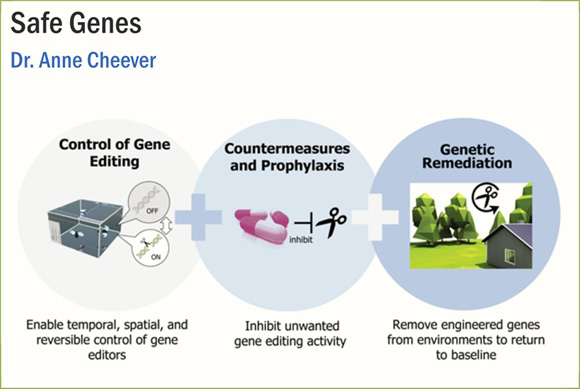Transhumanism & Artificial Intelligence
 |
 |
 |
 |
 |
 |
 |
Human Cyborgs are Just the Beginning - III
Ethics Must Regulate Neuro & Gene Tech
I spent a little time searching and webmining the more “interesting” DARPA projects. Below are just a few of the abstracts of research projects being funded by DARPA and the DoD:

These technologies are further along than we might think, and we deserve to know more about them. This is the future that our government is planning for us, whether we like it or not, and it is a future that is opaque. From genetic engineering to new synthetics development for neural implants, to replacing and enhancing limbs for warfare – our military is “going there.” But the truth is, some places “we” shouldn’t go. Just because they “can,” doesn’t mean they “should”.
If you have learned anything since January 2020, I hope that you have learned to question the wisdom and insight of the insider cliques within the US Government and “Administrative State” who believe that it is acceptable to march ahead with genetic and mechanical engineering of human beings without meaningful oversight, let alone self awareness and any sense of bioethical boundaries.
If we truly wish to have a say in these new technologies, society (which is to say “we”) must be informed. “We” have a right to be informed. That means you and me. As these technologies develop, transhumanism will become all the rage. Think about that. These new technologies will be what future generations will have to look forward to. Human cyborgs are their futures. They, that is human cyborgs, will be our children and our grandchildren.
"We are Borg. Resistance is futile. You will be assimilated. Your life as it has been is over. From this time forward, you will service us."
 Thanks, Paramount.
Thanks, Paramount.
The military is already working on propaganda to “reverse negative cultural narratives of enhancement technologies.” So, once again – we are being played before we even know what the playing field looks like.
Like I said before, we have all seen that movie too.
The full scope of this program needs to be revealed to the American people. Although the executive report barely mentions gene editing technologies, the military is investing heavily in them and clearly with the intention of using them for the war fighter. The executive report barely skims the surface of the research that is currently being carried out by DARPA, and that is only one office within the Department of Defense. The public’s right to know about this research and what the final goals are is crucial. Congress must demand answers and must demand open and transparent responses. As the report rightly points out, what happens in the military will make its way into the public sphere. We have a right to know what is being planned for our future “evolution.” I don’t use that word lightly. But that is how the UK Ministry of Defence has labeled human augmentation research.
Turns out that Silicon Valley darling and Klaus Schwab’s evil mini me Yuval Noah Harari (author of Homo Deus, which literally means “Man God”) is not so far out there in his thinking as we had thought.
The bioethics of human augmentation are complex. The regulatory processes must be developed before the technologies come into being, not the other way around. People must envision how these technologies will be used in civilian life, in military life and as life-saving treatments. People need to decide if and which of these technologies really are for the good of society. People need to become involved now.
That starts with education. Which begins with transparency by our government. In future Substacks, I hope that you and I will begin exploring the bioethics, the impact of these technologies, privacy issues, the targets, future visions of society and just what this all means.
This article was published on
Who Is Robert Malone on September 14, 2022
Given its extension TIA divided it in parts & is posting it as a series.

- The Measuring Biological Aptitude (MBA) program aims to address the need for a more capable fighting force by helping individual warfighters identify, measure, and track personalized biomarkers related to training and peak performance for specialized roles. If the program succeeds, MBA technologies will give warfighters the ability to understand the underlying biological processes that govern their performance.
Specifically, these technologies would elucidate the internal expression circuits (e.g., genetic, epigenetic, metabolomic) that shape militarily relevant cognitive, behavioral, and physical traits. New devices for continuously tracking these expression circuits could be integrated into the body to provide instantaneous user feedback, helping the warfighter to improve performance throughout training, assessment, selection, and mission execution for a given military specialty.
Human rationality & its power of decision are being reduced to just an electrical circuit...
- DARPA's multi-year AI Next portfolio of programs and investments seeks to develop contextual reasoning in artificial intelligence systems to improve human/machine teaming.
The Agile Teams (A-Teams) program aims to discover, test, and demonstrate generalizable mathematical abstractions for the design of agile human-machine teams and to provide predictive insight into team performance. While human-machine teams have been the subject of considerable past work in artificial intelligence and autonomy, designing agile team architectures remains largely a trial-and-error enterprise.
The A-Teams program seeks to create a systematic methodology to design teams that best use the capabilities of both humans and machines and that can achieve enhanced performance in uncertain, dynamic, and co-evolving environments. These new abstractions will be validated using experimental testbeds aimed to support reproducible evaluation of human-machine team architectures in a diverse range of problem contexts. - The Hand Proprioception and Touch Interfaces (HAPTIX) program is pursuing key technologies to enable precision control of and sensory feedback from sensor-equipped upper-limb prosthetic devices. If successful, the resulting system would provide users near-natural control of prosthetic hands and arms via bi-directional peripheral nerve implants.

- The Safe Genes program supports force protection and military health and readiness by protecting Service members from accidental or intentional misuse of genome editing technologies. Additional work will leverage advances in gene editing technology to expedite development of advanced prophylactic and therapeutic treatments against gene editors. Advances within the program will ensure the United States remains at the vanguard of the broadly accessible and rapidly progressing field of genome editing.
Safe Genes performer teams work across three primary technical focus areas to develop tools and methodologies to control, counter, and even reverse the effects of genome editing – including gene drives – in biological systems across scales.
First, researchers are developing the genetic circuitry and genome editing machinery for robust, spatial, temporal, and reversible control of genome editing activity in living systems.
Second, researchers are developing small molecules and molecular strategies to provide prophylactic and treatment solutions that prevent or limit genome editing activity and protect the genome integrity of organisms and populations.
Third, researchers are developing “genetic remediation” strategies that eliminate unwanted engineered genes from a broad range of complex population and environmental contexts to restore systems to functional and genetic baseline states.
Overall, the Safe Genes program is creating a layered, modular, and adaptable solution set to: protect warfighters and the homeland against intentional or accidental misuse of genome editing technologies; prevent and/or reverse unwanted genetic changes in a given biological system; and facilitate the development of safe, precise, and effective medical treatments that use gene editors. - The Next-Generation Nonsurgical Neurotechnology (N3) program aims to develop high-performance, bi-directional brain-machine interfaces for able-bodied service members. Such interfaces would be enabling technology for diverse national security applications such as control of unmanned aerial vehicles and active cyber defense systems or teaming with computer systems to successfully multitask during complex military missions.
Whereas the most effective, state-of-the-art neural interfaces require surgery to implant electrodes into the brain, N3 technology would not require surgery and would be man-portable, thus making the technology accessible to a far wider population of potential users. Noninvasive neurotechnologies such as the electroencephalogram and transcranial direct current stimulation already exist, but do not offer the precision, signal resolution, and portability required for advanced applications by people working in real-world settings.
Non-surgical neurological interfaces are being studied
to control the human mind
The envisioned N3 technology breaks through the limitations of existing technology by delivering an integrated device that does not require surgical implantation, but has the precision to read from and write to 16 independent channels within a 16mm3 volume of neural tissue within 50ms. Each channel is capable of specifically interacting with sub-millimeter regions of the brain with a spatial and temporal specificity that rivals existing invasive approaches. Individual devices can be combined to provide the ability to interface to multiple points in the brain at once.
To enable future non-invasive brain-machine interfaces, N3 researchers are working to develop solutions that address challenges such as the physics of scattering and weakening of signals as they pass through skin, skull, and brain tissue, as well as designing algorithms for decoding and encoding neural signals that are represented by other modalities such as light, acoustic, or electro-magnetic energy. - The Neural Evidence Aggregation Tool (NEAT) program aims to overcome current limitations by developing a new cognitive science tool that identifies people at risk of suicide by using preconscious brain signals rather than asking questions and waiting for consciously filtered responses. By aggregating preconscious brain signals to stimuli, NEAT would determine what a person believes to be true, false, or indeterminate about specific types of knowledge that could be used to detect signs of depression, anxiety, or suicidal ideation earlier and more reliably than ever before.
If successful, NEAT will not only significantly augment behavioral health screening, but it could also serve as a new way to assess ultimate treatment efficacy, since patients will often tell their clinicians what they think the clinician wants to hear rather than how they are truly feeling. Ultimately, NEAT intends to augment current behavioral health screening programs by providing clinicians with previously unavailable information to enable earlier interventions and more reliable measures of successful treatment.
These technologies are further along than we might think, and we deserve to know more about them. This is the future that our government is planning for us, whether we like it or not, and it is a future that is opaque. From genetic engineering to new synthetics development for neural implants, to replacing and enhancing limbs for warfare – our military is “going there.” But the truth is, some places “we” shouldn’t go. Just because they “can,” doesn’t mean they “should”.
If you have learned anything since January 2020, I hope that you have learned to question the wisdom and insight of the insider cliques within the US Government and “Administrative State” who believe that it is acceptable to march ahead with genetic and mechanical engineering of human beings without meaningful oversight, let alone self awareness and any sense of bioethical boundaries.
If we truly wish to have a say in these new technologies, society (which is to say “we”) must be informed. “We” have a right to be informed. That means you and me. As these technologies develop, transhumanism will become all the rage. Think about that. These new technologies will be what future generations will have to look forward to. Human cyborgs are their futures. They, that is human cyborgs, will be our children and our grandchildren.
"We are Borg. Resistance is futile. You will be assimilated. Your life as it has been is over. From this time forward, you will service us."

A sci-fi movie preparing for the coming future
The military is already working on propaganda to “reverse negative cultural narratives of enhancement technologies.” So, once again – we are being played before we even know what the playing field looks like.
Like I said before, we have all seen that movie too.
The full scope of this program needs to be revealed to the American people. Although the executive report barely mentions gene editing technologies, the military is investing heavily in them and clearly with the intention of using them for the war fighter. The executive report barely skims the surface of the research that is currently being carried out by DARPA, and that is only one office within the Department of Defense. The public’s right to know about this research and what the final goals are is crucial. Congress must demand answers and must demand open and transparent responses. As the report rightly points out, what happens in the military will make its way into the public sphere. We have a right to know what is being planned for our future “evolution.” I don’t use that word lightly. But that is how the UK Ministry of Defence has labeled human augmentation research.
Turns out that Silicon Valley darling and Klaus Schwab’s evil mini me Yuval Noah Harari (author of Homo Deus, which literally means “Man God”) is not so far out there in his thinking as we had thought.
The bioethics of human augmentation are complex. The regulatory processes must be developed before the technologies come into being, not the other way around. People must envision how these technologies will be used in civilian life, in military life and as life-saving treatments. People need to decide if and which of these technologies really are for the good of society. People need to become involved now.
That starts with education. Which begins with transparency by our government. In future Substacks, I hope that you and I will begin exploring the bioethics, the impact of these technologies, privacy issues, the targets, future visions of society and just what this all means.
Who Is Robert Malone on September 14, 2022
Given its extension TIA divided it in parts & is posting it as a series.

Posted October 14, 2022
______________________
______________________
 Volume I |
 Volume II |
 Volume III |
 Volume IV |
 Volume V |
 Volume VI |
 Volume VII |
 Volume VIII |
 Volume IX |
 Volume X |
 Volume XI |
 Special Edition |


